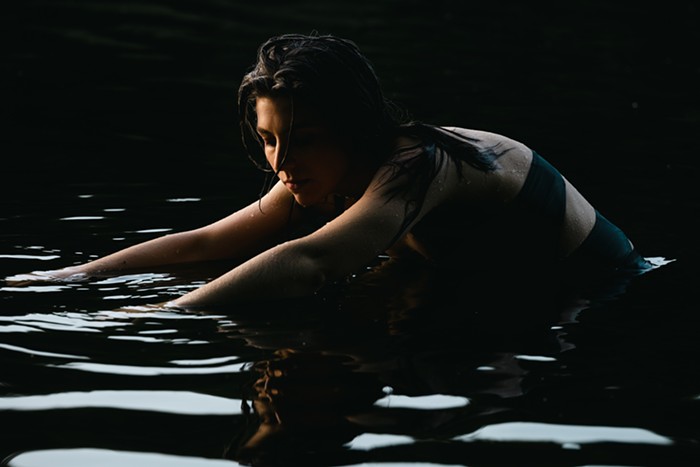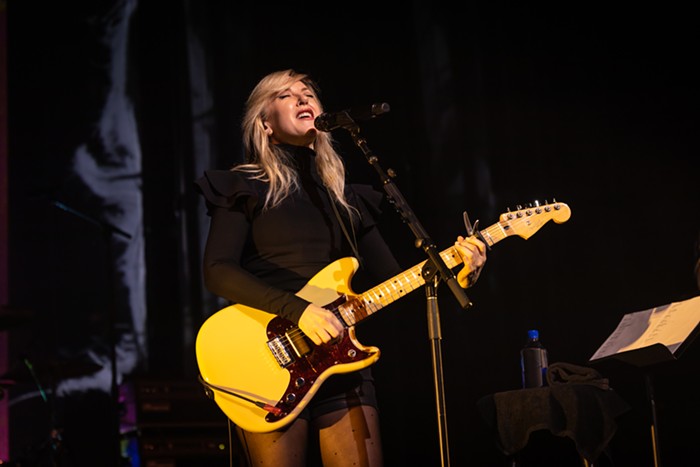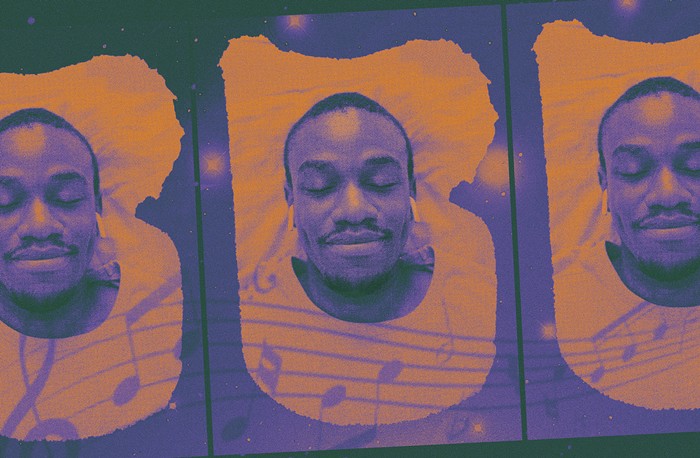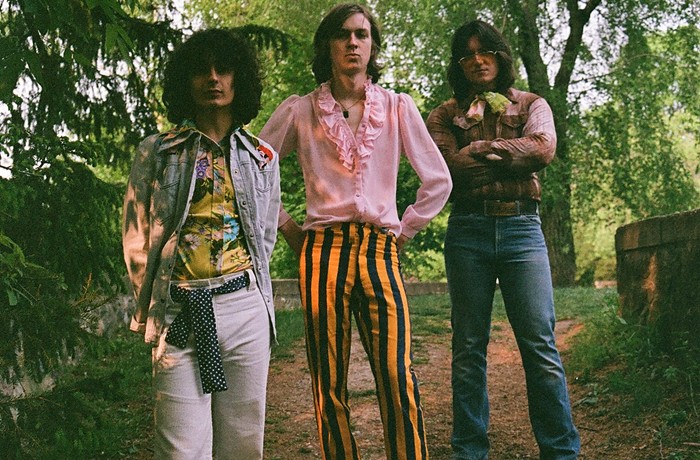Does the desire to throw yourself around in a river and cake yourself in mud come from a deep-seated rung of DNA code that pings out on gray winter days when our skin is parched for sun? Or were we all once elephants? The weird kicked blues of Lincoln, Nebraska, quartet UUVVWWZ makes you want just that—mud, all over your body, thick and warm. Singer Teal Gardner calls assertively through distorted dissonance with a bright, strident Karen O register. UUVVWWZ is pronounced double U double V double W Z. In the single "Open Sign," off their new Saddle Creek Records full-length the trusted language, Gardner stutters rhythmically and announces, "Arrival, arrival, arrival." The song zooms out from David Ozinga's drums. Jim Schroeder's guitar and Dustin Wilbourn's bass meld and bubble over into a whirlpool conclusion of discordant fizzling white noise. UUVVWWZ bring to mind the early-'80s zenith of Athens, Georgia, band Pylon. In the video for "Open Sign" there is mud. Lots and lots of mud. Teal Gardner and Jim Schroeder spoke. I was fully caked.
How did "Open Sign" happen as a song? It all builds to where you sing "Arrival." And repeat it. What has arrived? The sign? What's the sign?
Schroeder: I had the main riff, the one during the "arrival" part, sitting around for a year or two, and we couldn't fit it into anything. A couple of weeks before we went into the studio, we shoved it against the verse part and went from there. We "finished" the song the night before our first day in the studio, which made the song a little more exciting.
Gardner: "Open Sign" is such an important song to me. It works to distill this organized chaos that makes up part of my thoughts on the perversion of public space in the US. It started with the idea of an OPEN sign—those neon red-and-blue signs that announce a shop being open for business. Stripped of context, the sign simply states "OPEN." I chose to take "open" to mean receptive, engaged, interested, nonjudgmental, and even loving. Openness is a quality that I cherish and admire, and if spaces could declare themselves open for more than just business, well... [pauses]. Let's consider this, how much of the space in Omaha is green space/park space? How much is business district? How much is strip mall? How much is parking lot? How much is road? When I think about the comparatively very small amount of space allotted for people to simply "be" in a relationship with the world, unmediated by relationships of trade, it is an astonishingly small area.
The ever-encroaching arms of civilization.
Gardner: So the song winds in and out of my thoughts on the state of openness within public space and my own experience attempting to be open. The following lines refer to a lecture I heard by Alice Notley where she spoke of a "large public poem" she was working on—I was deeply touched by her acknowledgement of a need for something that unites us: "I saw and I saw and I tried to get Open, ran back to the beach and I tried to get Open." Some lines of my own enunciate my struggle with being open, "I can feel, you know, clear sometimes, open as a field of poppies in the right light, there is a line I haven't gone, crossing my mind, only so much time arrival." The idea of arrival is to become open and at peace with your relationship to the world—enough to be able to say that I have "arrived" within a sphere of reality where openness to the world, it is not a flitting, occasional, or circumstantial positioning, but a more permanent one.
Where did y'all record? Who produced? How were the sessions?
Schroeder: We first recorded bass and drums at ARC Studios in Omaha, with Ben Brodin engineering and JJ Idt producing. After that, we moved to a basement in Omaha where we did vocals, guitars, and trickery with JJ engineering and producing. Finally, we went to Fuse recording studios in Lincoln, where we mixed down in the nude from the computer to tape, had a little dance of accomplishment, jumped off a couple loading docks, and tried to play hacky sack with a piece of trash.
Whose idea was the mud for the video? Where was that filmed? Were y'all afraid the water would give you diseases?
Gardner: The mud wallow we used for the shooting is directly underneath the pedestrian bridge that connects Omaha to Council Bluffs, right on the banks of the Missouri River. I have to thank my friend Kjell Peterson for saving the day; he suggested we look at the riverbank when the other location I'd had in mind fell through. We were also lucky because the large dirt hill that appears at the beginning of the video was part of a new park being built on the riverfront on the Iowa side of the Missouri. We were the only people around, running up and down a dirt swath. It was extremely fun.
I brought some white clay that was a gift from my sculpture teacher, Santiago Cal. We put big chunks of that clay down in the dark brown mud so that there would be a contrast between the colors and textures of mud going on. As rain threatened most of the day, we were extremely lucky to have no downpour, though as it was, the camera people were taking great risks in putting the cameras at eye level with mud thrashing friends. Harrison Martin and I directed on the fly—the process of fulfilling ourselves in mud and dirt and water wasn't really one that needed much instruction. Toward the end of the shooting, we all took off toward the river and washed the mud off, defying the common stay away from river attitude that Omaha has. Although the city was founded because of the river, there is virtually no river access from the city. Our actions were transgressive, and satisfying.
What's your writing process? Do you have any superstitions? Like you have to be wearing your lucky forest-green Scooby-Doo socks when you record?
Schroeder: The worn path involves being fully clothed and playing guitar while Teal sings. Sometimes I have something prepared and occasionally Teal does. Then when we like it, we try to organize it, fail, bring it to Dave and Dustin, fail, and I play it over and over until it loses all meaning. And then success happens at some point. Some songs happen a little easier. "Charlotte's List" from the new album was arranged on the computer program Reason. I sent the files over to Teal, and she recorded a vocal. JJ helped a lot with my tones on the album. He had a couple extra pedals and Ben let us borrow a tape delay.
Gardner: The album recording went well, I thought. I was unfortunately sick with a cold and had a pretty bad throat throughout the recording process, so I was spraying my throat with some soothing herbal thing pretty much compulsively.
What is Lincoln, Nebraska, like?
Gardner: Lincoln. Lincoln. Lincoln. There is such a supportive and weird scene here. Come be here, there are people here working to make things be better. Music and art and anything else need weird dreamers. We have coffee.
What is some music out of Lincoln we should be checking out?
Schroeder: There are a lot of great bands in Lincoln. The Renfields, Touch People, Green Trees, Dads, Ron Wax, Powerful Science, to name a few. Dave is in another band called Shipbuilding Co. that's great. Oh, and Brother's Family Temple and Fuchsia Minutiae. And as long as we're shoutin' out, how about the Duke of the Hazardous Waste Pool, Plack Blague, Vickers. There are too many to name.
Where does the name of your band come from? Whoever came up with "Duhb-uhl-yoo-duhb-uhl-vee-duhb-uhl-duhb-uhl-yoo-zee" wins.
Schroeder: I guess I came up with it. It's truly a burden, and I would like to take this time to apologize. Sorry.
Artifacts are an interest of yours. What sort of artifacts do you like?
Gardner: I am assuming the artifacts you're referring to are those on the front cover of the album. Those items were gathered by myself and Neil Griess during walks around the streets of Lincoln. By working closely with cast-off materials that had entered the economy of the void, we wanted to rethink the value of such objects. Also, their decontextualization and somewhat alien appearance makes them all the more dynamic as objects in an arrangement like the one you see on the album cover. We treated the objects with dignity, first photographing them all, and then cutting out the photos of them. Then we rephotographed the original objects within a scape created by the photographs of them. So it is kind of like you're looking at re-representations of an original material. We were totally turned on by all of the colors and forms of the objects collected, so being able to interact with them in such a minute and obsessive way was really fun. ![]()



















